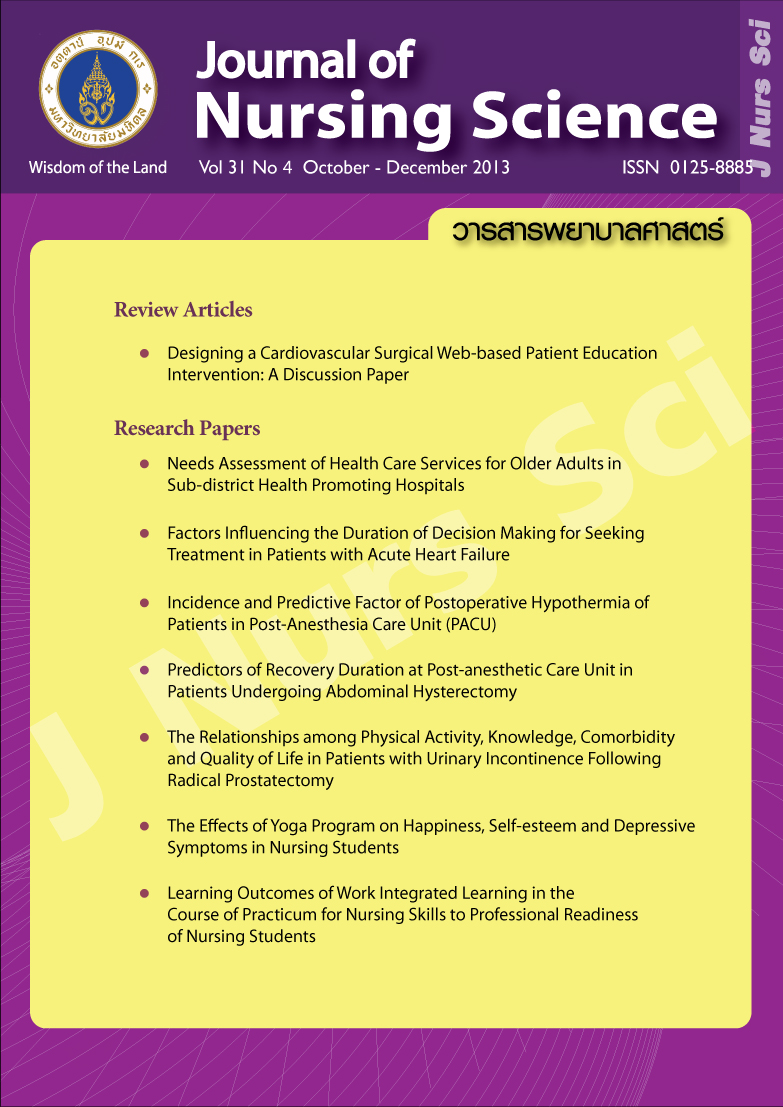Learning Outcomes of Work Integrated Learning in the Course of Practicum for Nursing Skills to Professional Readiness of Nursing Students
Main Article Content
Abstract
Purpose: To explore and compare the readiness toward nursing profession of nursing students before and after receiving Work Integrated Learning.
Design: Pretest-posttest one group design.
Methods: Subjects were 287 fourth-year nursing students. Data were collected by using nursing skills assessment form, attitude toward nursing profession assessment scale, emotional maturity assessment scale, and reflective record form before and after Work Integrated Learning. Descriptive statistics and dependent t-test were used for data analysis.
Main findings: Before Work Integrated Learning, students had a moderate level of readiness for nursing profession in experiences and practice skills. It significantly increased to a high level after Work Integrated Learning (p < .001). In addition, before Work Integrated Learning, they had a high level in readiness of emotional maturity and attitude for nursing profession. It also significantly increased to a high level after Work Integrated Learning (p < .01).
Conclusion and recommendations: Work Integrated Learning can be applied to nursing practice and creates good attitude toward nursing profession. The effective arrangement on education must have good collaboration among educational institutes, stakeholders, and students, including an adequate timeframe for practicum course. Further research should study the cooperative model of clinical practice teaching to improve nursing skills.
ผลการเรียนรู้การจัดการศึกษาเชิงบูรณาการกับการทำงานในวิชาปฏิบัติเสริมทักษะการพยาบาลต่อความพร้อมในการประกอบวิชาชีพของนักศึกษาพยาบาล
วิไลวรรณ ทองเจริญ, ช่อทิพย์ สันธนะวนิช, สกุลรัตน์ เตียววานิช, พัสมณฑ์ คุ้มทวีพร, วิไลพรรณ สมบุญตนนท์, ศุภาวดี วายุเหือด, กาญจนา ครองธรรมชาติ, พิจิตรา เล็กดำรงกุล, กลิ่นชบา สุวรรณรงค์
บทคัดย่อ
วัตถุประสงค์: ศึกษาระดับและเปรียบเทียบความพร้อมในการประกอบวิชาชีพพยาบาลของนักศึกษาก่อนและหลังได้รับการจัดการศึกษาเชิงบูรณาการกับการทำงาน
รูปแบบการวิจัย: ศึกษากลุ่มเดียววัดก่อน-หลังการทดลอง
วิธีดำเนินการวิจัย: กลุ่มตัวอย่างเป็นนักศึกษาชั้นปีที่ 4 จำนวน 287 ราย เก็บข้อมูลโดยใช้แบบประเมินทักษะการปฏิบัติการพยาบาล แบบวัดเจตคติต่อการประกอบวิชาชีพพยาบาล แบบวัดวุฒิภาวะทางอารมณ์ และแบบบันทึกการสะท้อนผลการปฏิบัติงาน ก่อนและหลังการจัดการเรียนรู้แบบบูรณาการกับการทำงาน วิเคราะห์ข้อมูลใช้สถิติเชิงพรรณนาและสถิติทีที่เปรียบเทียบค่าเฉลี่ยกลุ่มตัวอย่างกลุ่มเดียว
ผลการวิจัย: ก่อนการจัดการศึกษาเชิงบูรณาการกับการทำงาน นักศึกษามีความพร้อมต่อการประกอบวิชาชีพพยาบาลในด้านประสบการณ์และทักษะการปฏิบัติการพยาบาลอยู่ในระดับปานกลาง และเพิ่มขึ้นอยู่ในระดับมากหลังการจัดการศึกษาอย่างมีนัยสำคัญ (p < .001) ส่วนความพร้อมในด้านเจตคติต่อการประกอบวิชาชีพพยาบาลและวุฒิภาวะทางอารมณ์ของนักศึกษาก่อนการจัดการศึกษาเชิงบูรณาการกับการทำงานอยู่ในระดับมากและเพิ่มขึ้นหลังการจัดการศึกษาในระดับมาก เช่นเดียวกันอย่างมีนัยสำคัญทางสถิติ (p < .01)
สรุปและข้อเสนอแนะ: การเรียนรู้แบบบูรณาการกับการทำงานสามารถนำมาประยุกต์ใช้ในการปฏิบัติงานจริงและสร้างเจตคติที่ดีต่อวิชาชีพ การจัดการศึกษาที่มีประสิทธิภาพต้องมีความร่วมมือที่ดีระหว่างสถาบันการศึกษา ผู้ใช้บัณฑิตและนักศึกษา รวมทั้งมีระยะเวลาที่พอเพียงในการฝึกปฏิบัติ การศึกษาวิจัยต่อไปควรศึกษารูปแบบความร่วมมือในการเรียนการสอนภาคปฏิบัติเพื่อพัฒนาทักษะเชิงวิชาชีพ
คำสำคัญ: การเรียนรู้แบบบูรณาการกับการทำงาน ความพร้อมในการประกอบวิชาชีพ
Article Details
Copyright Notice: Nursing Science Journal of Thailand has exclusive rights to publish and distribute the manuscript and all contents therein. Without the journal’s permission, the dissemination of the manuscript in another journal or online, and the reproduction of the manuscript for non-educational purpose are prohibited.

Disclaimer: The opinion expressed and figures provided in this journal, NSJT, are the sole responsibility of the authors. The editorial board bears no responsibility in this regard.


